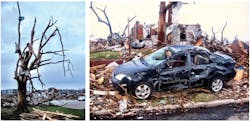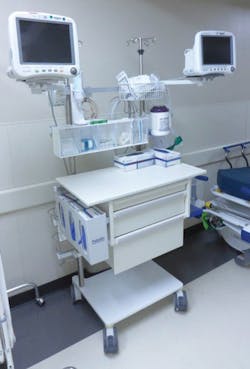Infection Prevention
The 2019 National Health Security Preparedness Index1 brought good news and bad news. The bad news is that 2018 was an extraordinary year for disasters, with hurricanes, storms, floods, fires, and extreme temperatures throughout the nation. The nation also faced outbreaks of hepatitis A and measles, the continuing rise in opioid deaths, as well as mass violence at schools, churches, and elsewhere.
Because where or when these events will happen usually cannot be anticipated, nor can it be foreseen how destructive they will be, “protections need to be available ‘everywhere’ in order to prevent disease and injury ‘anywhere.’”2
A number of factors contribute to the frequency and intensity of health-security threats, both in the U.S. and globally.3
- Extreme weather events such as storms, fires, floods, droughts, and temperature extremes
- Newly emerging and re-emerging infectious diseases such as Zika, Middle East Respiratory Syndrome, and Ebola
- Growing antibiotic resistance
- Incomplete vaccination coverage
- Globalization in travel and trade patterns
- Political instability, violence, and terrorism risks
- Aging infrastructure for transportation, housing, food, water, and energy systems
- Cybersecurity vulnerabilities
The good news is that, for the past six years, health security has improved in the U.S., with some regions moving ahead strongly and others still lagging behind. Contributing factors, according to the Index,1 likely include “an updated National Health Security Strategy, clearly defined capabilities for key sectors involved in health security and preparedness, community-engaged planning and protocol development, and regular testing of plans and protocols through exercises, drills, and responses to real events.”1
The 2019 National Health Security Preparedness Index1 states that the U.S. scores a 6.7 on a 10-point scale for preparedness. While that indicates progress, there is still much work to be done.
Who needs to be involved?
You’ve heard the expression “it takes a village to raise a child”; well, it takes a village to respond to disasters and outbreaks, too. Some experts weighed in on what is needed and who should be involved in preparations for the unexpected on a large scale.
Beth Krah, Owner and CEO, activTek Health Solutions, commented, “By nature, the term ‘disaster’ explodes outside the confines of any box, so our strategy in planning needs to outwit any disaster. The key is not only establishing strong relationships between each department within the facility, but with first responders, United States Public Health Service Commissioned Corp officers, the private sector, etc.
Gary M. Schindele, FHFI, President, Paladin Healthcare LLC, highlighted the importance of communication among those involved, “Unified command consists of all participants of an event being at a centralized command post with means to communicate directly with assets in the field. This includes hospitals, fire and emergency medical services, and law enforcement.”
“To be best prepared,” continued Kuppalli, “medical facilities should have a multidisciplinary hospital-incident command group that is activated in the event of a disaster or emergency. At the very least, this should include representatives from hospital administration, communications, security, nursing administration, human resources, pharmacy, infection control, respiratory therapy, engineering and maintenance, laboratory, nutrition, laundry, cleaning, waste management, and medical staff including intensive care, emergency medicine, internal medicine, pediatrics, obstetrics-gynecology, surgery, orthopedics, anesthesia, and radiology.”
“It is critical for all departments to work together during a crisis,” said Janet L. Lumbra, Director of Business Development, Mobile Medical International, Corp. Lumbra thinks it is most important that facilities and materials management, infection control, operating room, and sterile-processing management are involved, “to ensure ongoing safe service to patients and personnel.”
“Engineers have a unique contribution as well, in how HVAC systems affect outbreaks, environmental hazards associated with biological agents, and appropriate handling of utilities during natural disasters,” added Krah, activTek Health Solutions. “Knowledge gleaned from others’ experience on the front lines is invaluable. Science matters greatly as well, and technology is often available to aid significantly in mitigating mass-casualty incidents or other disasters.”
Advance planning
Obviously, the most important aspect of being prepared is planning ahead. Waiting until a disaster or outbreak strikes is dangerous for all. Alex Birrell, PhD, CEO, CleanSpace Technologies, noted, “In a crisis, prioritizing protection of healthcare workers (HCWs) can ensure a resilient frontline defense. In 2003, during SARS [Severe Acute Respiratory Syndrome outbreak], about 20 percent of the people infected in the U.S. were HCWs; in Canada, it was forty-three percent. There was little time for hospital preparedness policies to be implemented and resources scaled up.”
Kuppalli advised, “I think the most overlooked component of emergency and disaster preparedness is planning and being ready for the unexpected. Oftentimes, as a society, we are reactive to events when they occur rather than being proactive. As a member of IDSA, we are constantly monitoring disease outbreaks and pandemics around the world. People can go to our society site, www.idsociety.org, to get more information about various infectious diseases and prepare appropriately. If we have learned anything from the past, it is that there will be another emergency or disaster. We just do not know when or where. It is for this reason it is important that, as a society, we all prepare and be ready.”
Kuppalli, IDSA, described the main components of an emergency/disaster plan. “The essential components of an emergency/disaster plan are continuing essential services, developing an effective command and control, ensuring safety and security of staff and patients, clear and accurate internal and external communication, quick adaptation to increased demands on the system, efficient triage, appropriate use of scarce resources, effective human resource management, logistics and supply management, and a post-disaster recovery plan.”
Stressing the importance of participating in drills, Krah, activTek Health Solutions, insisted, “Take all training and exercises seriously. Preparing for if a disaster happens just gives the pathogen or storm the upper hand. It’s critical to approach training as when it will occur.”
Schindele talked about the importance of maintaining HCWs’ health and safety, so they can continue contributing their efforts to those who need them. “The first and foremost element of disaster management is to do no harm, to both responders and patients. Caregiver safety is the primary goal, to ensure that effective patient care can be delivered throughout the event. Keep in mind that disaster/mass-casualty events may involve damaged infrastructure, limiting re-supply and manpower reinforcements. Providers must be prepared to manage for extended periods of time in compromised conditions.”
Lumbra, Mobile Medical International, Corp, stated that the most important thing is “having a knowledge of the plan, first and foremost, with cooperation of all. The main components and tools needed to ensure success in preparing and responding during an emergency are continued access to power, clean water, supplies, and personnel/manpower, to continue offering services to patients.”
Krah continued, “Upstream strategic thinking is key to prevent infectious diseases from spreading. Diseases and contamination run rampant after natural disasters, and proper hygiene isn’t a priority when mom is desperately searching for her three-year-old. Having technology already in place can go a long way in mitigating the spread of such diseases.”
Product solutions are part of the strategy
Delivery of oxygen for mass-casualty events, major fire incidents, or other catastrophes is a challenge. Paladin’s Surge Gas Delivery System deploys in minutes, sets up in rough terrain, and can simultaneously supply eight victims with oxygen. It stores in a portable and easy to carry case.
Whatever the scenario, the need for personal protective equipment (PPE) likely will skyrocket. Birrell, CleanSpace Technologies, said, “PPE plays a critical central role in managing and containing infectious diseases. Globally, hospital PPE may be outdated, inconsistently adopted, and in short supply. There are 18 million HCWs across the 5,500 hospitals in the U.S., and 7.3 billion N95 masks are needed during a pandemic. Currently there are 60 million masks stockpiled.”
Birrell noted that inhalation of unknown contaminants or respiratory-infection outbreaks present a high risk to staff. “To protect staff, the focus must be on respiratory equipment. For years, hospitals relied on N95 masks; however, there are challenges with N95 masks including discomfort, heat, difficulties to fit, fogging, and the fact that they are disposable. There is a call for hospitals to evaluate reusable systems that will remove reliance on stockpiling disposable masks. The second issue is to incorporate mask PPE into routine care, so teams are familiar and confident with their respirators prior to a disaster.
Birrell added that CleanSpace HALO is lightweight and has no belts or hoses as with traditional powered air-purifying respirators. “Nurses love the cool, fresh air across their face, with no fogging, and the transparent mask means good communication with each other and the patients.”
Highlighting the need to have optimal PPE in stock, Birrell pointed to past outbreaks. “During SARS, HCWs accounted for 1,707 of the people who contracted the disease. During the first Ebola outbreak, at least 600 HCWs contracted the disease, of which half died. These cases highlight the vulnerabilities around the use and supply shortages of N95 disposable respirators. With N95s, managers can be faced with sending staff in to care for patients with used masks, or without protection at all, and this can result in potentially high rates of HCW stress, infection rates, and absenteeism. Hospitals adopting CleanSpace have trialed HALO and have acted to ensure their staff are protected and comfortable, and that their preparedness plans are robust.”
Mass violence and natural disasters can cause overload of the hospital’s surgery department, if indeed the hospital is still standing and in operation. Lumbra described how their solution fills the gap when the disaster strikes the hospital itself. “Mobile Medical International offers on-site surgery unit, sterile processing, and water-quality solutions that can provide the continuation of surgery and surgical-instrument processing while ensuring water quality.”
Citing a previous experience, Lumbra said, “Mobile Medical International provided two Mobile Surgery Units to ensure continuation of surgical services to St. John’s Regional Medical Center patients in Joplin, MO, immediately following the F-5 tornado’s destruction of their facility in May 2011. These units were utilized for a year while the hospital was being rebuilt.” For more details on how Mobile Medical International’s solutions allowed surgeons to continue operating after their hospital was destroyed, go to http://www.mmicglobal.com/Joplin.
Get ready
Catastrophes and outbreaks can happen anywhere. Small communities or large cities, none are exempt or spared, as we have seen time and again. Natural disasters are increasing. Mass violence is rising. Outbreaks are popping up with more frequency, with both old and new infectious diseases. There is no excuse not to be prepared. Information abounds. Use it. The next time an outbreak or disaster hits, you could be in the middle of it. Be ready.
References
1. Center for Public Health Systems and Services Research. National Health Security Preparedness Index 2019 Release Summary of Key Findings. Lexington, KY: University of Kentucky; May 2019. https://nhspi.org/wp-content/uploads/2019/05/NHSPI_2019_Key_Findings.pdf. Last accessed June 3, 2019.
2. Trust for America’s Health. Ready or Not? Protecting the Public’s Health from Diseases, Disasters, and Bioterrorism. Washington, DC: Trust for America’s Health; 2019. https://www.tfah.org/report-details/ready-or-not-protecting-the-publics-health-from-diseases-disasters-and-bioterrorism-2019. Last accessed June 3, 2019.
3. Intergovernmental Panel on Climate Change. Managing the Risks of Extreme Events and Disasters to Advance Climate Change Adaptation. Cambridge, UK: Cambridge University Press; 2012. https://www.ipcc.ch/pdf/special-reports/srex/SREX_Full_Report.pdf). Last accessed June 3, 2019.
About the Author

Susan Cantrell
Susan Cantrell is Infection Prevention Editor for Healthcare Purchasing News.





